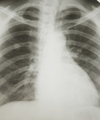February
Poorer patients with lung cancer less likely to receive treatment than wealtheir patients

Poorer lung cancer patients in the developed world are significantly less likely to receive treatment than richer patients, researchers from Newcastle University have found.
This inequality in treatment may contribute to the higher death rates for lung cancer in poorer patients.
In a paper published today in the journal PLoS Medicine the authors found that this disparity could not be explained by differences in national healthcare systems or the stage at which cancer is diagnosed.
The team from Newcastle University and Fuse, the Centre for Translational Research in Public Health, analysed data from 46 previous studies from the UK and the US and also from Canada, Sweden, Australia, Italy, France, and New Zealand.
In their analysis, the authors found that patients with lung cancer who were from the lowest socioeconomic groups were 21 % less likely to receive any treatment than patients from the highest socioeconomic groups. Lower socioeconomic position was also linked with a lower chance of receiving surgery (32% less likely) and chemotherapy (18% less likely), but not radiotherapy.
These findings are important as, in the UK and USA, lung cancer is the most common cause of cancer death and treatment with surgery, chemotherapy or radiotherapy improves survival rates in patients with lung cancer. A previous study in England and Wales has found that 1,300 lung cancer deaths could be avoided if survival rates were the same as the highest socio-economic groups.
The authors also found that this link between socioeconomic position and receiving treatment was similar in studies from countries where healthcare is free for everyone (for example, in the UK) and in countries that have private insurance healthcare systems (for example, in the US). It is unclear at the moment what is driving these inequalities in receipt of treatment.
Lynne Forrest, lead author on the paper and a PhD student within the Institute of Health and Society, said: “We were surprised that these inequalities remained even after we took account of the differences in healthcare system and in how advanced the cancer was at diagnosis.
“We do not know why this is happening, but we think it could be due to three possible factors.
“Firstly co morbidity; poorer people may have other things wrong with them, making them unable to undergo aggressive cancer treatment.
“Secondly patient choice; poorer people may weigh up the benefits of treatment differently and therefore turn down the opportunity for treatment that could extend their life for a short while. There may be socioeconomic barriers to treatment uptake, such as access to transport, family circumstances, work flexibility and social support, that influence whether patients choose to undergo treatment.
“Thirdly, it may be that doctors are not communicating effectively with poorer or less well-educated patients. All of these factors will need to be looked at, as well as any others that we may uncover in future research.”
Professor Martin White, Director of Fuse and study co-author added: “This is a serious public health concern that needs to be addressed. We are discovering that a range of health conditions are subject to inequalities in the way that healthcare is accessed and delivered. These can lead to unequal outcomes which may compound the already unequal distribution of diseases in the population.”
Reference: Socioeconomic Inequalities in Lung Cancer Treatment: Systematic Review and Meta-Analysis
Lynne F. Forrest, Jean Adams, Helen Wareham, Greg Rubin, Martin White
published on: 7 February 2013
